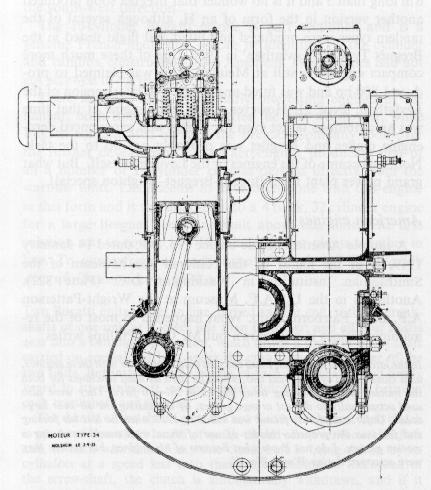

Editor: Jaap Horst

In 1915, while working for the French government, Ettore designed a 250HP straight-eight, as shown above. This was basically very similar to two enlarged Garros engines put in line. The propellor was not fixed to the crankshaft, but to a shaft somewhat shifted to the above/right side, which was driven through reduction gear, at a ratio of 32 to 47. The rear propellor shaft bearing was mounted on the side of the crankcase and not forward in the usual manner, which kept overall length to a minimum.
The eight cylinder Bugatti engine was a vertical water-cooled type of 110mm bore and 160mm stroke, making a displacement of 12 liters. Compression ratio was 5 to 1, and the engine developed 210HP at 1880rpm, and 250HP at 2160. Cylinders were from cast iron, in blocks of four. The single overhead camshaft was made in two sections and driven from the centre of the crankshaft by bevel gears. Two inlet and one exhaust valve were operated by separate rocker arms. The exhaust valve stems were made hollow for the purpose of cooling by air circulation. The crankshaft was built up from two conventional four-cylinder shafts that were coupled together at right angles by a tapered joint at the center main bearing. (See the drawing of the King-Bugatti engine). Nine plain main bearings were used. The connecting rods had shanks of H section, and the aluminium pistons were fitted with 5 rings. The cooling water was circulated by a centrifugal pump, and dual ignition was provided by two H-L-8 Bosch magnetos. The dry weight was said to be 220kg (485lb).
To my knowledge no aircraft were ever equipped with the Bugatti 8-cylinder engine.
The engine may not have been fully developed, but the license was sold to Diatto in Italy and Delaunay-Belleville in France and some 8-cylinder models were also brought by Friderich to the USA. One source (Dumont) states that Peugeot was ordered to produce the engine in France, but it is highly questionable if any were made.
Bugatti kept improving his engine, and towards the end of the war designed a version with increased stroke of 180mm.
The French were not really interested in the U16, but the Americans were, leading to a contract to build engines in the USA, these are the famous King-Bugattis. In France the development of the engine was taken up by Breguet after the war.
Reportedly the engine was used in a Morane Saulnier, without any success. Some of the later Breguet developments were used by Breguet in some airplanes, without much succes though.
This 125x180mm engine of 34 litres was designed, though never built. The general layout is very similar to the WWI U-16 engine. The design is interesting in that the crankshaft is suspended from the cylinder block, as used later on the Royale (T41), T50 and others. The main bearings also seem to be water cooled, as on the Royale. Also it appears that the crankshaft has proper pressure lubrication, Like in the King-Bugatti!
Another one is the degree of involvement of Ettore Bugatti in the later development of the Breguet engines. To Borgeson it seems impossible that he was not somehow involved in this, moreover because the Breguet H32 is like the culmination of the Bugatti idea, who himself began by making a two-cylinder at Prinetti and Stucchi by combining two single-cylinder engines. Than the T14 which was a kind of "straight eight" with two T13 engines mounted in one chassis, and finally the U16 aeroengines of 1916 and 1925, and of the T45 and T47 Automobiles, combining two straight-eights to make a 16-cylinder engine!
It may seem that all this designing of aeroengines was of no use, however the money Bugatti will have made by selling the Licenses, especially the $100.000 for the license to the Americans, helped him in getting started again in Automobile Manufacturing after WWI. The development of these engines added much to the engine design for his cars, the 8-cylinder aero-engine being the first straight eight, even showing some of the straight - cut features typical for all of the later engine-designs. The T34 was very much like a double-Royale engine, especially in the way the main bearings were suspended from the cylinder-blocks, and not part of the crank-case!
A King-Bugatti engine can be seen at the National Air Museum of the Smithsonian Institution in Washington D.C., and one in the USAF museum at the Wright-Patterson AF Base at Fairborn, Ohio.
Become a member of the Bugatti Aircraft Association!
The U-Sixteen of 1925, Type 34

The Type 50B of 1938
As the T50B engine was used in the Bugatti 100/110P airplane, we might call it an airplane engine! The two of them should be able to do some 900HP!The Type 60 of 1939
This was a design for an eight cylinder aero-engine of 4.1 litre, 86x88mm. It was to have four valves per cylinder. It may have been intended also as a replacement for the 3.3 litre racecar engine (T59)
Some questions remain unanswered here, like if the first two engines had any Type-numbers, fitting into the general Bugatti Nomenclature.
It is seen here how cunning Bugatti was in selling his product at a time that it was not really well developed, claiming performance of the engine that never had been met. The story of the ":American connection" is a very interesting one, and can be read in the Borgeson book.
Museum engines
The best place to visit is the Musee de l'air at Chalais-Meudon, 2 rue des Vertuajadins, Meudon, just outside the Paris boundaries in the south west direction. There is a French U-16 engine here to be seen, as well as two Breguet-Bugatti engines and a 1.5 litre Brescia engine. Of the Breguet Bugattis at least one is of the H-32 type.
Aircraft Engines / Aircraft / License Aircraft Engines / Bugatti powered / Bibliography / index